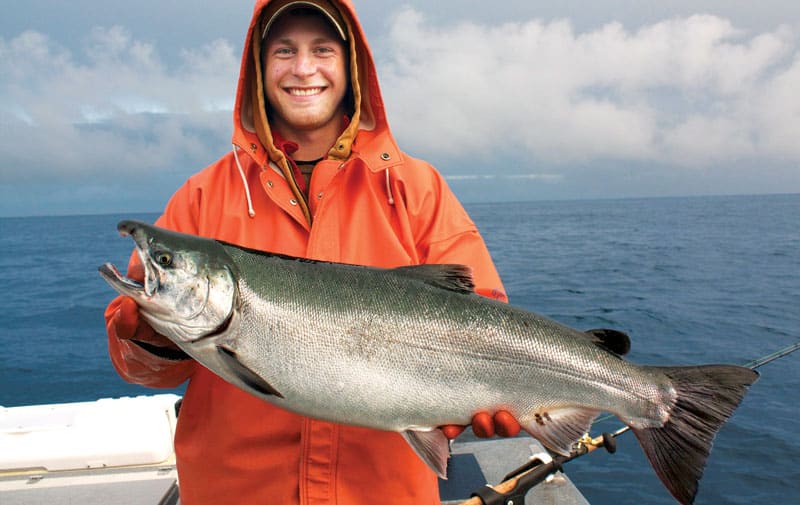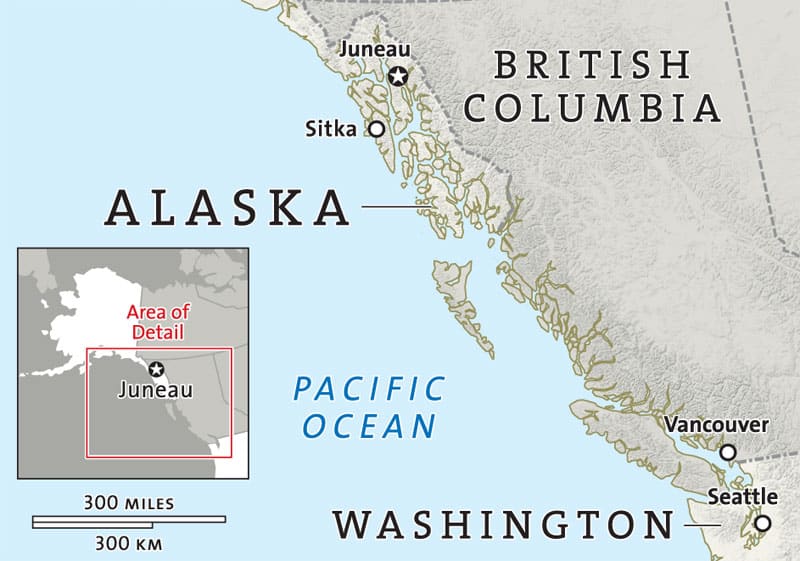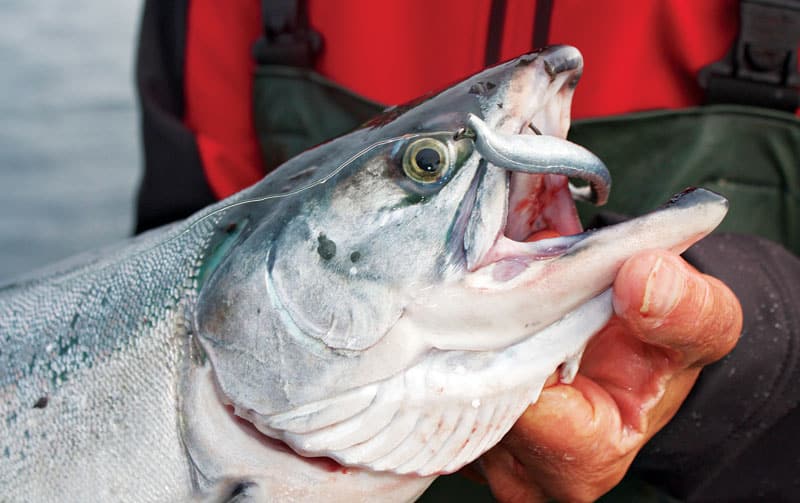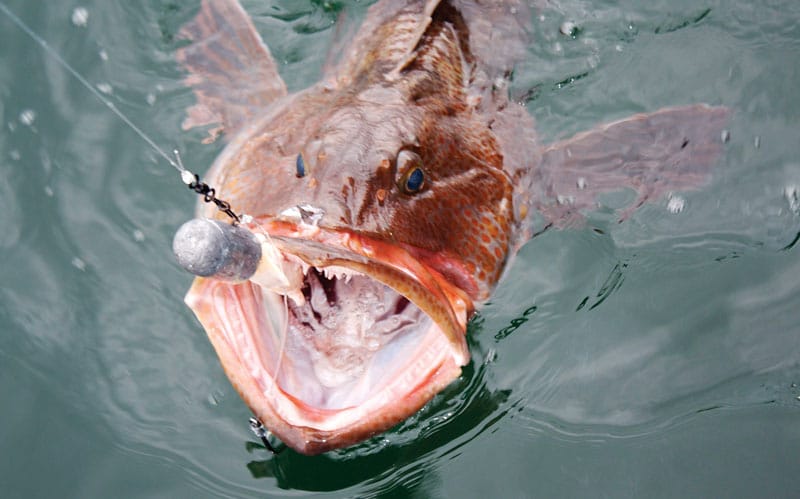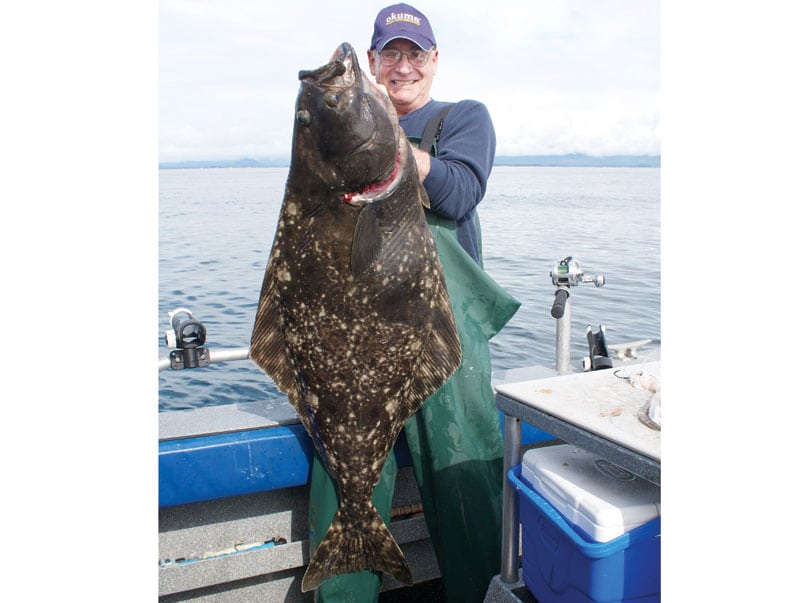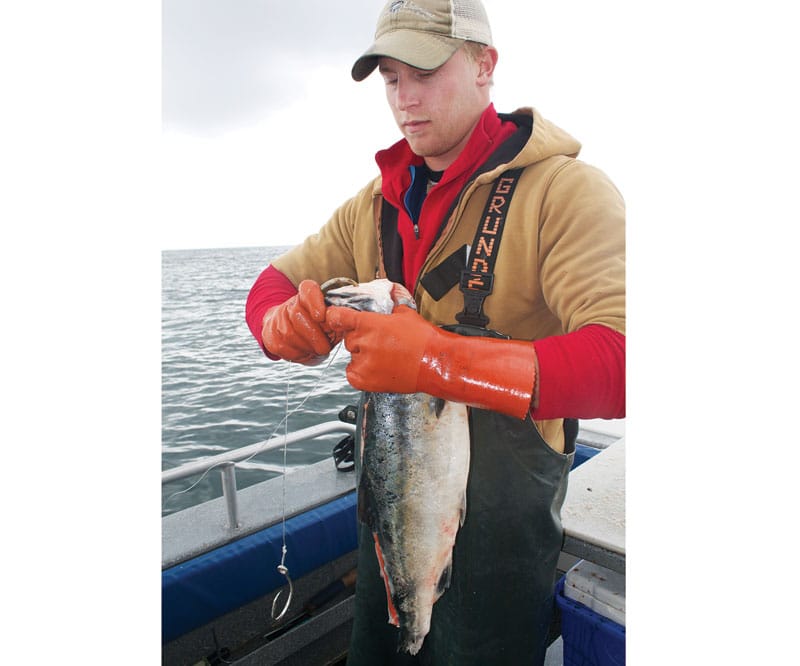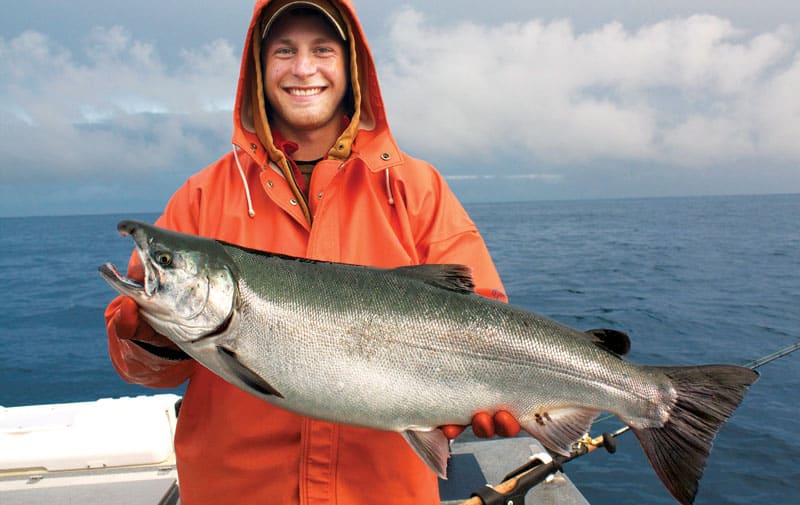
Sitka’s Abundant Salmon
Some say the fishing in Alaska is so good that anybody can catch fish. This is true to some extent — the remote waters around Sitka teem with silver and king salmon, giant halibut, brightly colored rockfish and alligator-size lingcod.
Depending on the season in these remote waters, some or all of these fish are usually ready to pounce on baits or lures lowered into their midst.
That the fish are large, numerous and willing here doesn’t mean that serious anglers won’t have their skills — as well as their stamina — put to the test. Capt. Tom Ohaus, noted outdoors writer and co-owner of Angling Unlimited in Sitka, sees all kinds of clients over a typical season, from first-timers to old salts. The ones who enjoy the greatest success, he says, are those who keep their minds open and listen to the captain.
**
Salmon Time**
The waters around Sitka are rife with king (chinook) salmon up to 50 pounds and coho (or silvers) running from 8 to 20 pounds. Sitka, on the Pacific shore of Baranof Island, is ideally situated to benefit from annual southward salmon migrations. These waters are also rich in herring and needlefish, providing salmon an ideal stopover in which to fatten up before heading upriver to spawn.
While annual runs can overlap, action on kings is usually best from May until late July. Big numbers of silvers usually start showing up in late June and can be around through mid-September, when most lodges shut down for the season.
Whether fishing for king or silver salmon, Ohaus and his Angling Unlimited guides prefer the hands-on technique of mooching to trolling, in which fish hook themselves. Mooching is certainly more fun for anglers, but it also makes them more responsible for their own success or failure.
“Salmon fishing is unique,” says Ohaus, who, in addition to his other credentials, has a degree in fisheries biology. “I know this because I’ve fished all over the U.S. and the world. The gear for salmon is different, the bite is different, and the most effective response isn’t what you would do for a striped bass, tuna or other species. Even experienced salmon fishermen from other parts of the country make the mistake of assuming the fish we catch in Alaska behave like fish in their home waters.”
Magic Carpet Ride
Another attraction that brings anglers to Sitka is the opportunity to snag carpet-size Pacific halibut. While the majority of the catch are 10- to 40-pound “chickens,” there is always a chance of hooking a monster. An Angling Unlimited client in 2010 managed to drag up a 430-pound behemoth after a thrashing, shotgun-blasting battle captured on home video (and viewable at anglingunlimited.com).
Ohaus likes to anchor in 150 to 220 feet over flats with gravel bottoms and nearby high structure when targeting “small” inshore halibut up to 60 pounds. He found a spot like this on our trip, and I downsized my tackle to target these flatfish with lighter than usual gear and artificial lures. I brought along a three-piece conventional travel rod and compact lever-drag reel, which I used to bounce soft-plastic lures and heavy iron jigs over the bottom. It takes a 10- to 12-ounce lead-head or lure to stay down in the heavy currents. Still, the strong take and fight of a big halibut or lingcod on 65-pound braid and this relatively light rig is a blast.
Go Deep
“Most of the really big halibut we catch come from offshore, in depths of 300 to 500 feet, with the best action near but not on the structure,” Ohaus says. “We like to anchor right on the edge, where the rock meets flat, hard bottom. Ideally, you want the current running toward the rocky structure.”
Fishing halibut on the anchor like this requires a fair amount of sitting and waiting, at least until the scent of the salmon bellies, herring and fish guts coaxes these roving bottom feeders under your boat. “We generally fish halibut with large baits on circle hooks or smaller baits on J hooks or jigs,” says Ohaus. “With the big circle hooks, the key to hooking a halibut is patience. Let the rod tip go down and stay down, then reel into the resistance. Halibut grab a bait, pull hard and drop it. But they almost always return to try again. They may return to a different rod, but they just can’t help themselves.”
Heavy Tactics
Ohaus also offers specific advice for anglers fishing halibut with heavy 16- to 24-ounce lead-head lures or heavy metal jigs. “Once you set the hook with the jig, keep reeling, and always keep the rod bent,” he says. Dropping the rod tip or lifting and pumping can allow the weight of the lure to dislodge the hook. “The action of jigs usually brings more bites, but you’ll lose a lot of fish if you don’t stay tight to them.”
Lingcod frequent the same rock-gravel transition zones and often grab deep baits meant for halibut. Since these are the same popular bottomfish we catch in Southern California, but four times larger, I like to target them using oversize versions of the same artificial lures I use at home. Bouncing a heavy lead-head/plastic combo on my travel rod, I released numerous lingcod from 30 to 40 pounds. At Ohaus’ suggestion, I added a trap hook with a small strip of salmon belly, which increased hookups when these sea monsters swiped at my lure with their bucket-size mouths.
Salmon Strategies from Ohaus
1. Watch the bait. “One of the challenges for new moochers is keeping bait away from the sinker so it doesn’t tangle on the drop. Most anglers aren’t accustomed to an in-line sinker attached to 7 feet of leader and a spinning bait. If you drop the sinker straight under your rod tip, the bait will spin over the main line. You need to throw the rig so the leader straightens out, to prevent tangling.”
2. Drop fast, and don’t wait. “Maintain thumb control, and let the bait fall quickly to the depth prescribed by the skipper. The skipper watches the action on the sounder all day and will target the depth. If he says ‘school of fish at 80 feet,’ get your gear there as fast as possible. Ninety-nine percent of the time, you’ll get a bite. We use line-counter reels, which make it easy for anglers to know how much line they have out.”
3. Stay alert for the bite. “The biggest mistake anglers make is instantly jerking on the rod in a futile attempt to set the hook. Salmon don’t ambush baits; they keep swimming forward and up, creating slack line. Fish with the rod tip low and stable. When you feel a bite, stabilize the rod, study the tip and confirm that the fish is there. Salmon bites are subtle. Once you confirm the bite, reel as fast as possible until the rod nearly doubles over and the drag is slipping. By then, the salmon will usually turn away and hook itself.”
**
4.** Stay in the fight. “Fighting salmon is much like fishing other fish, with one exception — salmon are more inclined to sudden changes of direction. If your line goes slack, don’t assume you’ve lost the fish. Reel like crazy, because it may be running right at you.”
Alaska Panhandle
Angling Unlimited caters to small groups fishing aboard comfortable Almar cabin boats. The lodge features two waterfront buildings with comfortable accommodations and fully stocked kitchens. Those staying in the lodge’s Sitka Rock Suites can fall asleep to the gently lapping waves or cast for silver and pink salmon literally from the property’s backyard.
AU’s guides specialize in hands-on fishing techniques, so you learn new skills and use them, which may explain why 90 percent of bookings are repeat.
Angling Unlimited books three-, four-, five- and six-day fishing adventures running from May 15 to Sept. 10.
What: Salmon, halibut, lingcod and rockfish.
When: Spring and summer.
Where: Sitka, Alaska.
Who: Angling Unlimited
Capt. Tom Ohaus
Sitka, Alaska
800-297-3380
www.anglingunlimited.com
Fishermen can book online or by phone year-around.
Other: 2011 Rates are $2,275 for three days’ fishing and four nights’ lodging. Sitka is reached easily by daily jet service from Seattle.
Angling Unlimited provides all salmon and halibut fishing gear. Three-piece travel bait-casting and conventional rods can add some light-tackle fun.
Travel outfits are easy to bring along, and they let you try new and interesting techniques. The Okuma Nomad NT-C-703L-ML matched to an Okuma Makaira 10 spooled with 65-pound-test braid I packed was perfect when fishing lures for halibut and lingcod up to 50 pounds. The three-piece rod is sized to stow easily in an overhead bin, or slip it into a duffel if you choose to use up what has become valuable space in checked bags. It also features an extra tip section, which allows you to change the rod action to match the quarry and conditions.
**
Rods:** For salmon, 8- to 81/2-foot mooching rods with parabolic action. Stout 51/2- to 6-foot stand-up outfits for halibut and lingcod fishing.
**
Reels:** Star-drag levelwind reels with line counters for salmon. Large 4/0 to 6/0 reels for halibut and bottomfishing.
**
Lines:** 25-pound mono for salmon mooching. Heavy Dacron or braid for halibut.
Lures: Heavy iron jigs and plastic tails on 12- to 24-ounce lead-heads.
